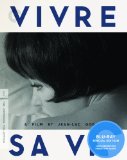| Reviews & Columns |
|
Reviews DVD TV on DVD Blu-ray 4K UHD International DVDs In Theaters Reviews by Studio Video Games Features Collector Series DVDs Easter Egg Database Interviews DVD Talk Radio Feature Articles Columns Anime Talk DVD Savant Horror DVDs The M.O.D. Squad Art House HD Talk Silent DVD
|
DVD Talk Forum |
|
|
| Resources |
|
DVD Price Search Customer Service #'s RCE Info Links |
|
Columns
|
|
|
Vivre sa vie
The Criterion Collection // Unrated // April 20, 2010
List Price: $39.95 [Buy now and save at Amazon]
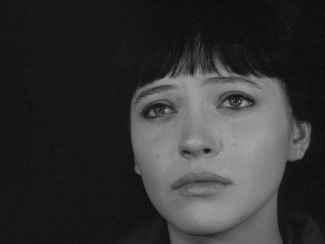 |
| [click on the thumbnail to enlarge] |
This being a Criterion release of one of the most iconic films of the French New Wave, it follows that the disc and its accompanying liner notes are teeming with analysis: Nana finding freedom within the constraints of her poverty and prostitution, the relationship between sex and commerce, the dominance of shadows representing the growing darkness in Nana's life, and how thought and language are intertwined, to mention just a few. It's beyond argument that Vivre sa vie is a film that lends itself to dissection and close critical review, but everything the film is about ultimately returns to the camera's unflinching fascination with Nana...with Anna Karina. (It can be difficult to tell where one ends and the other begins, and that's rather the point.)
Perhaps I'm getting ahead of myself. Nana lives for the moment, something a carefree twentysomething can't exactly afford in Paris on a shop girl's meager salary. She can't be bothered to think ahead. It's why she's already knee-deep in advances from her job but can't pay the rent on her apartment. It's why she's dressed in such strikingly fashionable clothes but is caught swiping a thousand franc bill that may or may not have fallen to the ground in front of her at a newsstand. She isn't quite certain why it is she's so dissatisfied with her most recent lover, but she's young and beautiful; there are more than enough men vying for Nana's attention for her to feel compelled to come up with a proper explanation. Her dream is to break into film, and she already has one role to her name. How large or how small it may have been is unclear, but when boasting about sharing the screen with a marquee draw, forthrightness only gets in the way.
Nana still dreams of capitalizing on her looks and becoming a star of stage and screen, but it's a considerably less glamorous opportunity that seems to offer her a way out of poverty. After a humiliating experience in a police station, Nana is simply walking down a disreptutable street when a man solicits her. Without a moment's hesitation, Nana agrees, falling into prostitution with casual disregard as if she'd simply been asked for the time. Nana fumbles her way through her first experience but doesn't present herself as particularly debased or degraded afterwards. Her curiosity only grows, and before long, she's
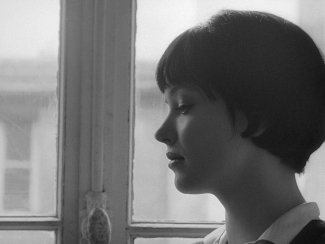 |
| [click on the thumbnail to enlarge] |
Jean-Luc Godard looks at his wife -- loves her -- through the camera lens. It's his voice that's reading Poe's "The Oval Portrait" as the film's final moments draw near, and it's all but impossible to overlook the similarities between that short story and Vivre sa vie. The former is the tale of a painter more infatuated with his art than his wife, so consumed that as his paint splashes against the canvas to form her portrait, the life is drained from her body. At its end, the painter has captured her beauty and essence but has destroyed the woman herself in the process. It's that sort of relationship that defines Vivre sa vie: that of painter and muse...of director and actress...of pimp and prostitute. The gulf between Anna Karina and Nana is deliberately blurred. By giving his wife her lines only moments before shooting and even then generally limiting her to a single take, Godard deliberately set out to keep her off-guard...to prevent her from adequately preparing for her performance. Nana often doesn't seem like some sort of cinematic construction but Karina baring her soul -- her raw emotions -- on the screen. The result is something so genuine...so sincere...that a far more seasoned actress than Karina would struggle to capture the same.
Despite drawing from a judge's study on prostitution in Paris, Godard condemns neither Nana nor society. His goal is not to scowl with judgement but simply to observe, taking care to construct the story so that it can't ever get in the way. Godard makes the intriguing choice of introducing each of the film's twelve tableaux with a title card explaining what's to come: one reads "The Police — Nana Is Questioned", while another notes "Nana Wonders Whether She's Happy". Knowing what's to follow without any other setup beforehand is tantalizing, and expressly stating what's bobbing around in Nana's head ensures that the audience will pay that much closer attention to her mood, her movements, and her expressions than perhaps they would have otherwise. These sequences often begin in media res and end without a traditional resolution. Still, sometimes fragments can be more telling than a complete story since the focus is directed where it's intended to be. For instance, there's Nana being questioned by a police officer after she's accused of swiping a thousand franc note from a woman who'd dropped it. Most any other movie would show the event either as it happened or in a flashback. Not so in Vivre sa vie. What actually occurred is inconsequential; the emphasis is instead properly placed on a humiliated Nana quietly fumbling through an explanation. Throughout the film, the camera tries never to cut away from Karina any longer than absolutely necessary, and even then, Godard is so enthralled with the pauses...by the quiet moments...that he resists the temptation to edit them out. Vivre sa vie uses cuts very sparingly, to the point that Nana writes an entire letter in real-time. The camera focuses in on pen and paper, and we're to read the words as they come. There isn't any sort of dreamlike imagery or narration to accompany it, and Karina takes care to pause periodically as Nana mulls over what to write next. The truth is revealed by the film's disinterest in looking elsewhere.
At the same time, Vivre sa vie could hardly be mistaken for some sort of stab at Neorealism. Godard as ever explores the
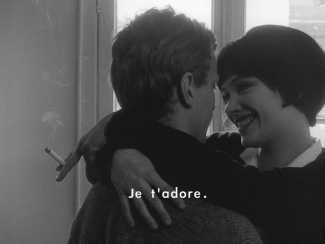 |
| [click on the thumbnail to enlarge] |
Deservedly one of the most enduring works of the French New Wave, Vivre sa vie is a remarkable film. Raoul Coutard's cinematography is certainly beautiful, and I'm not just saying that because he keeps the camera aimed at Anna Karina for nearly every frame of the film's 84 minute runtime. Vivre sa vie is so intensely oriented around close-ups and medium shots, and yet it still evokes an unmistakable sense of Paris without once resorting to the familiar clichés. Godard's fourth film proved to be his bleakest and most serious at that early point in his career, but the darkness never overwhelms; glimmers of joy and happiness still manage to sear a path through the shadows. Anna Karina offers a performance that's both raw and hypnotic: one borne far more by pauses, subtle gestures, and expressions than by reams of scripted dialogue. Godard takes care to coax out this truth yet is compelled to distance the viewer. Interweaving the two could quickly have proven disastrous, but Godard executes this delicate balancing act with supreme skill. By drawing the audience in and then pushing them away, Vivre sa vie both engages and provokes...appeals to both the emotional and the intellectual sides of the audience. This is a film that demands to be discussed and analyzed, and it rewards repeat viewing. Cheerful escapist fare it's not, no, but Vivre sa vie easily ranks among the New Wave's most enduring masterpieces, and especially considering the marvelous treatment lavished upon the film by Criterion here, its release on Blu-ray very much comes highly recommended.
Video
As
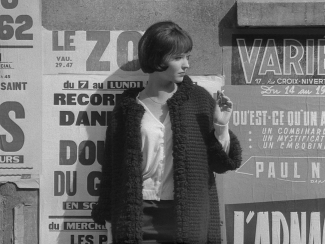 |
| [click on the thumbnail to enlarge] |
I've stumbled upon some murmurs on Blu-ray message boards of excessive brightening or contrast boosting applied to Vivra sa vie. I personally wouldn't agree. There are a handful of shots where black levels strike me as more of a milky gray, but this isn't at all a pervasive problem, with contrast generally coming across as reasonably robust. Whites are certainly never blinding or unnaturally bright, and highlights aren't the least bit blown out. There is some faint ringing around areas of high contrast, however. It's not terribly distracting in and of itself, and the excerpts in the six year old interview elsewhere on this Blu-ray disc reveal similar issues, suggesting that this is either culled from an older master or that the haloes date back to the original photography. The ringing itself didn't bother me, no, but regardless of the reason why these artifacts appear, they do cast certain shots in somewhat of an unnatural look. This is an extremely minor concern, of course, nitpicking the inches that separate "on the brink of..." and "perfection". Vivre sa vie looks gorgeous on Blu-ray and is very much in keeping with the dizzingly high standards that Criterion has set on the format.
Vivra sa vie is presented on a dual layer Blu-ray disc, with one layer essentially devoted to the movie's high bitrate AVC encode. The image is pillarboxed to preserve the film's original aspect ratio of 1.33:1.
Audio
Most films have their soundtracks meticulously crafted piece by piece in post-production; Vivre sa vie, on the other hand, was essentially recorded and mixed on a single track in real-time during principal photography. The only notable exception is the addition of the score, and even this doesn't apply to the diagetic music in the film, as it too was captured live during production. An essay in the liner notes delves far more in-depth into this daring experiment, one that ensured that Vivre sa vie's soundtrack is as natural and authentic as the imagery splashed across the screen. Jean Collet's 1962 essay notes some of the happy accidents captured through this technique, such as a hospital bell that rings at the moment of one character's untimely death and the sound of a lumbering truck that perfectly punctuates Nana prostituting herself for the first time. It also points out the downsides which are still discernable on the monaural PCM soundtrack offered on this Blu-ray disc, namely that in certain scenes, Vivre sa vie's dialogue is barely discernable. Of course, this being a French film, the English subtitles render this a rather moot point, and the fact that Vivre sa vie has sounded this way for nearly five full decades obviously means that it should in no way be considered a flaw with this Blu-ray disc. All things considered, the PCM audio comes through well enough. Frequency response is limited, and the reproduction of the dialogue suffers from some mild strain, but none of this seems at all unreasonable or unexpected. Even with just a single channel at its disposal, Vivre sa vie does a marvelous job fleshing out a strong sense of atmosphere, a fact I'd jotted down in my notes even before becoming aware of the film's unusual method of recording. Given that, how can I consider Godard's aural experiment to be anything but a success?
Again, Vivre sa vie is presented in its original French with no alternate mixes or dubs to distract from Godard's original intentions. English subtitles are enabled by default.
Extras
- Audio Commentary: Vivre sa vie features a commentary track by Adrian Martin, one of five that the Australian critic has recorded for Godard's films over the past few years. Martin certainly has no shortage of insight to offer on Vivre sa vie, avoiding any lulls in the conversation throughout the film's 84 minute runtime. He begins by contrasting Vivre sa vie with the three other films that Godard had helmed at this point in his career and notes a number of the rules of cinema that it shatters. As is the case with the interview offered by Jean Narboni elsewhere on this disc, Martin also delves into Nana's freedom within the contraints she faces and the allure of prostitution throughout its director's body of work. He draws a parallel between Godard's relationship with his wife Karina and that of pimp and prostitute and explains why he believes Vivre sa vie marked the start of the dissolution of their marriage. Among the many other highlights are the thematic interplay between light and shadow, comparing and contrasting Nana with Joan of Arc, Godard reducing several variations of a musical theme to just a few bars, Godard's approach to direction focusing more intensely on actions rather than character insight, and noting why he believes the film's opening dedication to B-movies is so appropriate.
A typo on the menu incorrectly notes that this commentary was recorded in 2001; considering that Martin mentions the death of editor Agnès Guillemot in late 2005, it certainly couldn't have been been recorded any time before then.
- Jean Narboni on Vivre sa vie (45 min.; SD): Jean Narboni, one of
the foremost experts on Godard's work in film, also speaks at length about Vivre sa vie. Narboni's comments cut a wide swathe, including its actors managing to deftly avoid the camera at the outset, why prostitution is such a mainstay throughout Godard's œuvre, how the reading of "The Oval Portrait" reflects the relationship between Godard and Karina during the production of Vivre sa vie, and what the extensive use of fades to black represent in the film's final tableaux. It's a thoughtful, inspired discussion of the film and its many themes, taking the time to discuss some of its less heralded sequences and exploring in detail Vivre sa vie's philosophical bent. There's surprisingly little overlap between this interview and the disc's audio commentary, and both are well worth setting aside the time to give a listen.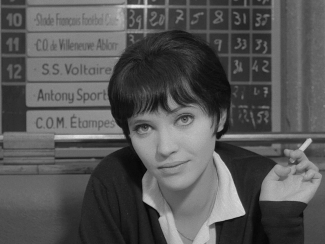
[click on the thumbnail to enlarge]
Narboni's interview is conducted in French and is subtitled.
- Cinépanorama - Anna Karina (11 min.; SD): Conducted shortly before the premiere of Vivre sa vie, this 1962 interview with Karina primarily focuses on her arrival in Paris with little familiarity of French and barely a cent to her name, her ascent to stardom in fashion and film, and, of course, her relationship with Godard. Perhaps the highlight is Karina debunking the rumor that she settled into the role of Godard's girlfriend/muse from an ad he'd placed in an industry trade.
- Faire face - La prostitution (22 min.; SD): A 1961 episode of the French news magazine delves into the world of prostitution and why the police seem so helpless to do much of anything about it. Judge Marcel Sacotte, who penned the original study, is interviewed, as are an investigator and a handful of prostitutes. Among the topics here are the scale of prostitution in Paris, how a woman might find herself seduced into this life, and a debate about the necessity of prostitution.
- Où en est - La prostitution (HD): Further exploring La prostitution, this extra offers a number of high-res scans from Sacotte's 1959 study, including a look at the 'classic letter' that Godard incorporated into his film verbatim. An excerpt of an essay by James Williams, spanning just over a page, touches on Godard's incorporation of La prostitution into Vivre sa vie.
- Godard's Trailer (2 min.; HD): Rather than make any attempt to summarize the film in the traditional sense, Godard's trailer for Vivre sa vie chooses instead to condense the entire film down to 144 seconds, cutting together brief looks at sequences from some of its earliest frames to the last.
- Stills Gallery (HD): The last of Vivre sa vie's extras is a gallery of 37 high resolution production stills and promotional art.
Vivre sa vie also boasts a spectacular set of liner notes, including Godard's original concept for the film, an insightful essay by Michael Atkinson, a pair of lengthy interviews with Godard from 1962, and detailed notes about the experimental live recording and mixing of the film's soundtrack.
The Final Word
With Vivre sa vie, Godard observes his then-wife Anna Karina with a documentarian's fascination while still indulging an impish curiosity with testing the outermost boundaries of convention. The melding of raw emotional truth with jarring cinematic experiments both draws the audience in yet keeps them at a distance: a combustible mix that in lesser hands could've gone disastrously wrong. Not so in the case of Vivre sa vie, one of the most admired and endlessly studied films of the French New Wave. Criterion has lavished the film with a gorgeous high definition presentation and an uncompressed soundtrack. As if that weren't enough to warrant an upgrade over Fox Lorber's DVD from nearly a decade past, Criterion has also assembled a healthy selection of extras to offer some additional insight into Vivre sa vie and to better explore the judge's report that inspired it nearly a half-century ago. Highly Recommended.
|
| Popular Reviews |
| Sponsored Links |
|
|
| Sponsored Links |
|
|
| Release List | Reviews | Shop | Newsletter | Forum | DVD Giveaways | Blu-Ray | Advertise |
|
Copyright 2024 DVDTalk.com All Rights Reserved. Legal Info, Privacy Policy, Terms of Use,
Manage Preferences,
Your Privacy Choices | |||||||









